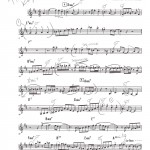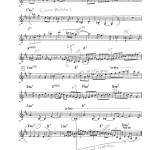Audio clip: Adobe Flash Player (version 9 or above) is required to play this audio clip. Download the latest version here. You also need to have JavaScript enabled in your browser.
Download the Transcription: Bb, Eb, C, Bass Clef
I got this disc when I was a freshman in college. My wife (girlfriend at the time) got it for me, and the first track that stuck out was this one. The groove is what first got me. The groove is this really great double time feel that is real open in the drums and piano. It just feels so good! And after hearing Nicholas’ playing on this track I knew I had to one day transcribe it. The first thing I noticed when I took some time to dig in was that they play with a double time feel, so it sounds like the chord changes go by at half speed. Payton’s solo fits so gently in to the groove, he’s simply an extension of the rhythm section.
Amongst all of the recent gigs Nicholas is playing, he’s also been active on both Twitter and Facebook. He often comments on the state of “jazz.” He claims he does not play “Jazz,” but he plays Black American Music. He says jazz, as we know it, is dead. This is not to minimize what the greats in the music did before him, but to build on it. Payton has gotten quite a bit of hate from friends, colleagues, and followers for his recent rants on jazz, some of them calling him the Charlie Sheen of Jazz. Needless to say, he’s certainly opened the conversation, and it’s one we should all be having anyway. I have always looked up to Payton, since getting in to this music. The music he makes is always inspiring to me, and I’ll take in to consideration what he has to say about the state of jazz since, you know…he is the state of jazz.
Anyways, I guess this site is somewhat of a “old ways meet the new” type thing. Transcribing, and learning tunes and solos by ear has been how this art was learned since the beginning. This site is simply an extension of that. So there.
Analysis:
I analyzed the solo in the trumpet key (Bb), because that’s what I transcribed with and practice the solo in. There are concert, bass clef, and Eb parts in PDF available above.
There are so many great figures for analysis in this solo. I mark Guide Tones (3rds and 7ths) on every big beat (1 & 3). Soloists often use Guide Tones as target notes or launch points.They’re all over on the strong beats in Payton’s solo. There are a couple of sequencial moments that are worth noting, both in mm 11 and 12, and mm 15-18. Nick does such a wonderful job of picking an idea and developing it. He brings several motives back during his solo, pulled from the beginning. Mostly what sticks out to me is his sense of feel and time. He manipulates the time and feel as good as anyone, and knows just when to utilize the soulful side to his playing. His dominant chords are almost always altered to hell. In mm 51 Payton plays the #9, b9, b5, natural 9, all in the same measure.
One of my favorite moments is the last 8 bars or so of this solo. He plays a couple of Bbs, making you think he’ll resolve to the A. He gets close a couple of times, develops for about 6 bars, and then finally does resolve down the the A, the 5th of the one chord. In the analysis I marked the first Bb and drew a line to show where it finally resolves.
Explanation of Analysis Terms
GTM = Guide Tone Movement
Guide tones are thirds and sevenths in every chord. (over an A7 chord, that is C# and G). “Guide Tone Movement” is when the soloist resolves one guide tone to another. For instance, in a ii V7 I in Cmaj, if the sololist moves from the seventh in G7 (F) to the third in CMA7 (E), that is guide tone movement.
GT = Guide Tone
I mark guide tones only when they are played on big beats, one and three. GT are often used as foundation, or jumping off points for the soloist to go in to more uncharted territory
Modes
I will sometimes mark the scale mode the soloist is using if I like how it is used.
ANT = Anticipation
When the soloist plays notes outside of a chord in anticipation of the next chord.
CAT = Chromatic Approach Tone
An example of a Chromatic Approach Tone is when the soloist surrounds the resolution note with half steps. For instance, if the soloist plays Ab-F# over a G7 and resolves to G over the CMA7, that is CAT.
Alterations
I will sometimes circle alterations if I like how they are used over a particular chord or passage.


Couple of things:
First, Nicholas Payton checked the transcription out and let us know that he actually arpeggiates an E minor 7th chord (concert) on the second to last bar of the solo. That means the F natural on the and of 3 is an F#. Super cool that he checked it out, we’re grateful that he’s cool with us posting his work.
Second, it seems as though my poor choice of words (i.e. “rant”) has caused the point of the second paragraph to become somewhat misconstrued. “Rant” does not accurately portray Payton’s recent blog posts on his website found here: http://nicholaspayton.wordpress.com/
Rant, by definition, means to “speak or write in an angry or violent manner.” That’s not fair to Nicholas, and it is not what I was trying to say. I meant that he has been talking about the state (or non-state) of jazz in a passionate manner. I don’t think he would disagree that he’s very passionate about the subject, and has had to account for his words amongst many of his colleagues. Naturally, it frustrates him when some kid (me) writes about his passion and clouds the message with poor vocabulary.
All that being said, I am, and many others are still trying to understand (some have just written it off) what Nicholas is saying about this music we all love and have spent our whole lives studying. After reading his posts, I feel like I am beginning to “get it,” though I am not sure I could ever really “get it,” since so much of his point of view comes from a Black American perspective, something I could never fully understand.
Still, we come from the same lineage, Nicholas and I. We’ve studied the same players, and sometimes, play the same music, whatever you’d like to call it, or not call it. Of course, Nicholas is at another level, but I’d like to think I’m on my way.
Needless to say, I hope you enjoy studying the solo as much as I enjoyed learning it myself.